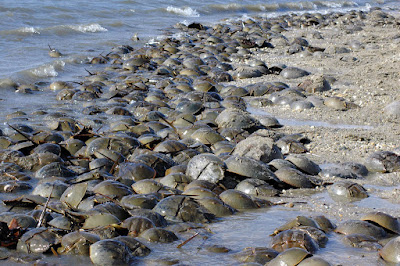 |
| USFWS Photo |
Late April means that a ritual of "living fossils" moving onto beaches will happen again.
The Wetlands Institute newsletter reminded me that the migration and spawning of horseshoe crabs has been happening for more than 450 million years is here again.
And where is the largest population of spawning horseshoe crabs in the world? Delaware Bay.
They can be found from Maine to the Yucatan Peninsula. Limulus polyphemus, the American Horseshoe Crab, is actually more closely related to spiders, ticks, and scorpions than crabs.
The migration and spawning also brings shorebirds who are migrating from Central and South America to Delaware Bay for a rest stop and critical meal. The shorebirds have a 3,000 – 9,000 mile annual journey to their Arctic breeding grounds.
Humans have a variety of positive and negative interactions with horseshoe crabs.
- Native Americans along the Delaware Bay and River ate their eggs.
- They were used as fertilizer and hog food in in the 1800s and it was an active industry on Delaware Bay.
- Their white blood cells contain a chemical (LAL) used to test for contaminants in injectable drugs and vaccines and other medical applications.
- They are still used as bait to catch eel and channeled whelk, mostly for overseas markets, but NJ has a moratorium on the harvesting of the crabs due to over-harvesting.
- Development along the Delaware Bay has reduced access for the crabs to spawn, but there are ongoing restoration efforts.
 |
| Baby horseshoe crab - via Wikimedia |
A number of groups participate in the reTURN the Favor project
which works to rescue stranded horseshoe crabs by freeing crabs
and working on projects to help remove debris from beaches.
May 20-21
with workshops, demonstrations, and field trips that focus on the crabs
and their role in shorebird migration.
 |
| Mating pair of horseshoe crabs - via Wikimedia |
No comments:
Post a Comment